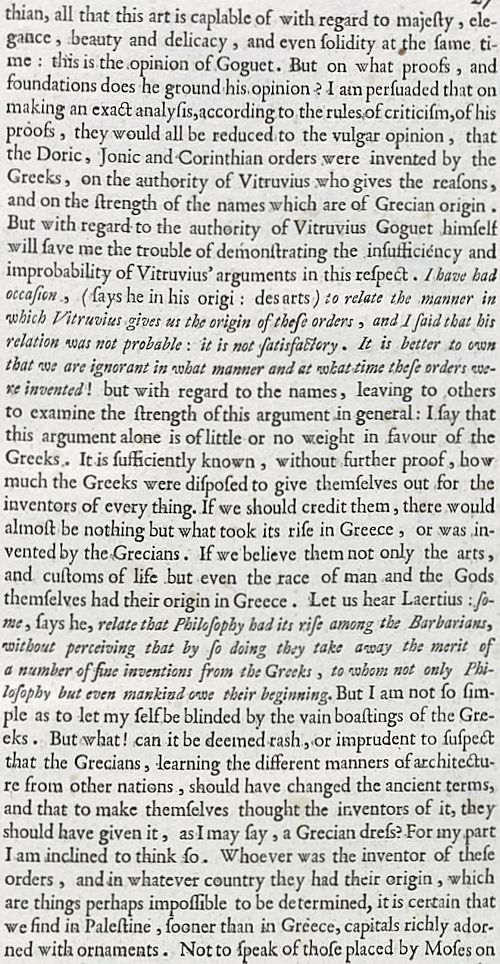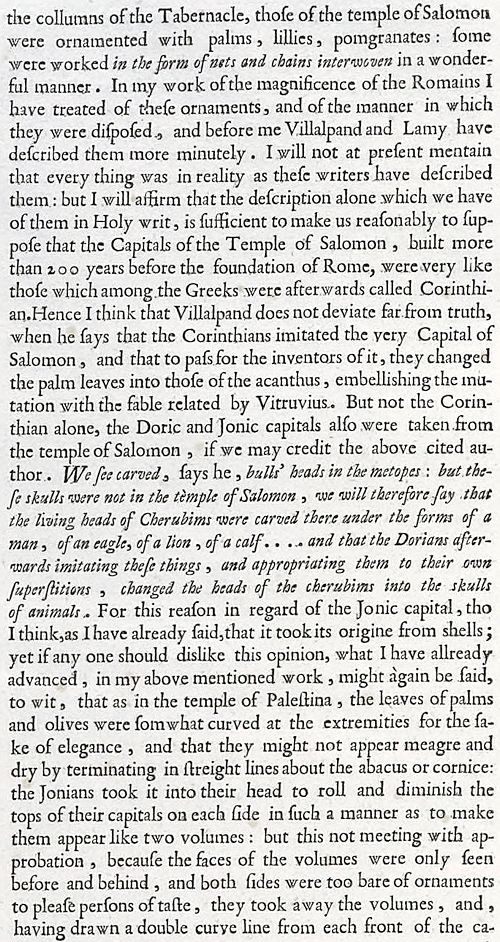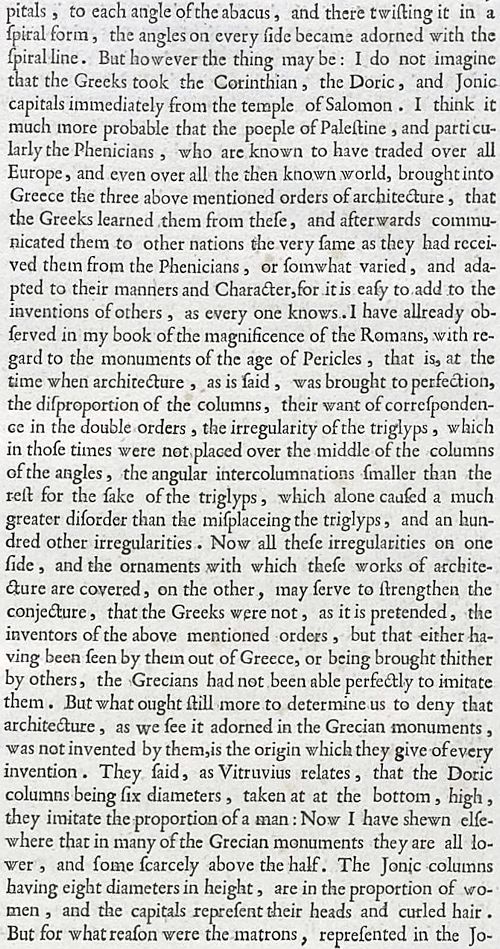
all that this art is caplable of with regard to majesty, elegance, beauty and delicacy, and even solidity at the same time: this is the opinion of Goguet. But on what proof, and foundations does he ground his opinion? I am persuaded that on making an exact analysis, according to the rules of criticism, of his proofs, they would all be reduced to the vulgar opinion, that the Doric, Ionic and Corinthian orders were invented by the
Greeks, on the authority of Vitruvius who gives the reasons, and on the strength of the names which are of Grecian origin. But with regard to the authority of Vitruvius Goguet himself will save me the trouble of demonstrating the insufficiency and improbability of Vitruviusí arguments in this refpect. I have had occasion, (says he in his origi: des arts) to relate the manner in which Vitruvius gives us the origin of these orders, and I said that his relation was not probable: it is not satisfaftory. It is better to own that we are ignorant in what manner and at what time these orders were invented! but with regard to the names, leaving to others to examine the strength of this argument in general: I say that this argument alone is of little or no weight in favour of the Greeks. It is sufficiently known, without further proof, how much the Greeks were disposed to give themselves out for the inventors of every thing. If we should credit them, there would almost be nothing but what took its rise in Greece, or was invented by the Grecians. If we believe them not only the arts, and customs of life but even the race of man and the Gods themselves had their origin in Greece. Let us hear Laertius: some, says he, relate that philosophy had its rise among the Barbarians, without perceiving that by so doing they take away the merit of a number of fine inventions from the Greeks, to whom not only Philosophy but even mankind owe their beginning. But I am not so simple as to let my self be blinded by the vain boastings of the Greeks. But what! can it be deemed rash, or imprudent to suspect that the Grecians, learning the different manners of architecture from other nations, should have changed the ancient terms, and that to make themfelves thought the inventors of it, they should have given it, as I may fay, a Grecian dress? For my part I am inclined to think so. Whoever was the inventor of these orders, and in whatever country they had their origin, which
are things perhaps impossible to be determined, it is certain that we find in Palestine, sooner than in Greece, capitals richly adorned with ornaments. Not to speak of those placed by Moses on
| |

the collumns of the Tabernacle, those of the temple of Solomon were ornamented with palms, lillics, pomgranates: some were worked in the form of nets and chains interwoven in a wonderful manner. In my work of the magnificence of the Romans I have treated of these ornaments, and of the manner in which they were dispofed, and before me Villalpand and Lamy have described them more minutely. I will not at present mantain that every thing was in reality as these writers have described them: but I will affirm that the description alone which we have of them in Holy writ, is sufficient to make us reasonably to suppose that the Capitals of the Temple of Solomon, built more than 200 years before the foundation of Rome, were very like those which among the Greeks were afterwards called Corinthian. Hence I think that Villalpand does not deviate far from truth, when he says that the Corinthians imitated the very Capital of Solomon, and that to pass for the inventors of it, they changed the palm leaves into those of the acanthus, embellishing the mutation with the fable related by Vitruvius. But not the Corinthian alone, the Doric and Ionic capitals also were taken from the temple of Solomon, if we may credit the above cited author. We see carved, says he, bulls' heads in the metopes: but these skulls were not in the temple of Solomon, we will therefore say that the living heads of Cherubims were carved there under the forms of a man, of an eagle, of a lion, of a calf .... and that the Dorians afterwards imitating these things, and appropriating them to their own superstitions, changed the heads of the cherubims into the skulls of animals. For this reason in regard of the Ionic capital, tho I think, as I have already said, that it took its origin from shells; yet if any one should dislike this opinion, what I have already advanced, in my above mentioned work, might again be said, to wit, that as in the temple of Palestina, the leaves of palms and olives were somewhat curved at the extremities for the sake of elegance, and that they might not appear meager and dry by terminating in straight lines about the abacus or cornice: the Ionians took it into their head to roll and diminish the tops of their capitals on each side in such a manner as to make them appear like two volumes: but this not meeting with approbation, because the faces of the volumes were only seen before and behind, and both sides were too bare of ornaments to please persons of taste, they took away the volumes, and, having drawn a double curve line from each front of the capitals,
| |

to each angle of the abacus, and there twisting it in a spiral form, the angles on every side became adorned with the spiral line. But however the thing may be: I do not imagine that the Greeks took the Corinthian, the Doric, and Ionic capitals immediately from the temple of Solomon. I think it much more probable that the people of Palestine, and particularly the Phoenicians, who are known to have traded over all Europe, and even over all the then known world, brought into Greece the three above mentioned orders of architecture, that the Greeks learned them from these, and afterwards communicated them to other nations the very same as they had received them from the Phoenicians, or somewhat varied, and adapted to their manners and character, for it is easy to add to the inventions of others, as every one knows. I have already observed in my book of the magnificence of the Romans, with regard to the monuments of the age of Pericles, that is, at the time when architecture, as is said, was brought to perfection, the disproportion of the columns, their want of correspondence in the double orders, the irregularity of the triglyps, which in those times were not placed over the middle of the columns of the angles, the angular intercolumnations smaller than the rest for the sake of the triglyps, which alone caused a much greater disorder than the misplaceing the triglyps, and a hundred other irregularities. Now all these irregularities on one side, and the ornaments with which these works of architecture are covered, on the other, may serve to strengthen the
conjecture, that the Greeks were not, as it is pretended, the inventors of the above mentioned orders, but that either having been seen by them out of Greece, or being brought thither by others, the Grecians had not been able perfectly to imitate them. But what ought still more to determine us to deny that architecture, as we see it adorned in the Grecian monuments, was not invented by them, is the origin which they give of every invention. They said, as Vitruvius relates, that the Doric columns being six diameters, taken at at the bottom, high, they imitate the proportion of a man: Now I have shown elsewhere that in many of the Grecian monuments they are all lower, and some scarcely above the half. The Ionic columns having eight diameters in height, are in the proportion of women, and the capitals represent their heads and curled hair. But for what reason were the matrons, represented in the Ionic
|